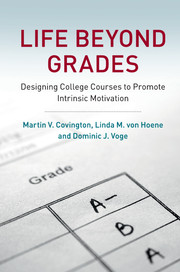Book contents
- Life Beyond Grades
- Life Beyond Grades
- Copyright page
- Dedication
- Contents
- Figures
- Tables
- Preface
- Acknowledgments
- 1 Introduction and Overview
- 2 The Sum of All Doubts
- 3 Roles and Responsibilities
- 4 Prospects for Intrinsic Task Engagement
- 5 Solutions as Goals
- 6 Scaffolding Problem-Solving Strategies
- 7 Partnering Instruction and Assessment
- 8 From Goals to Final Grades
- 9 The End of the Beginning
- Book part
- Notes
- References
- Index
- References
Appendices
Published online by Cambridge University Press: 26 July 2017
- Life Beyond Grades
- Life Beyond Grades
- Copyright page
- Dedication
- Contents
- Figures
- Tables
- Preface
- Acknowledgments
- 1 Introduction and Overview
- 2 The Sum of All Doubts
- 3 Roles and Responsibilities
- 4 Prospects for Intrinsic Task Engagement
- 5 Solutions as Goals
- 6 Scaffolding Problem-Solving Strategies
- 7 Partnering Instruction and Assessment
- 8 From Goals to Final Grades
- 9 The End of the Beginning
- Book part
- Notes
- References
- Index
- References
- Type
- Chapter
- Information
- Life beyond GradesDesigning College Courses to Promote Intrinsic Motivation, pp. 255 - 274Publisher: Cambridge University PressPrint publication year: 2017



